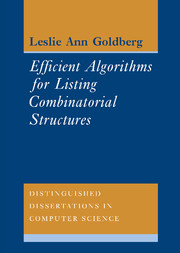Book contents
1 - Introduction
Published online by Cambridge University Press: 14 January 2010
Summary
Introduction
This thesis studies the problem of designing listing algorithms for families of combinatorial structures. In particular, it studies the problem of designing listing algorithms whose implementations do not use overwhelming quantities of computational resources. The computational resources that are considered are running time and storage space. Using standard terminology from complexity theory, we indicate that the time and space requirements of an algorithm are small by saying that the algorithm is “efficient”.
Section 1 of this chapter introduces our problem by defining the notion of a family of structures. It explains informally what we mean by a listing algorithm for a family of structures without discussing computational details. Section 1.2 motivates the study, describing three reasons that the problem deserves attention. Section 1.3 gives the phrase “listing algorithm” a precise meaning. In this section we specify a deterministic computational machine and a probabilistic machine. We discuss the process of implementing combinatorial listing algorithms on these machines. Section 1.4 establishes criteria which we will use to determine whether or not a given listing algorithm is efficient. The criteria will be sufficiently general that we will be able to change the computational machines that we consider (within a large class of “reasonable” machines) without changing the set of families of combinatorial structures that have efficient listing algorithms. Section 1.5 contains a synopsis of the thesis. Finally, section 1.6 contains some bibliographic remarks.
- Type
- Chapter
- Information
- Publisher: Cambridge University PressPrint publication year: 1993

